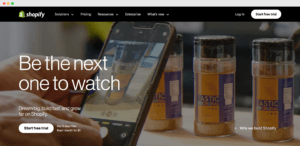
Migrating from WordPress to Shopify can be a strategic move for businesses looking to streamline eCommerce management. However, such a migration can bring a host of SEO, development, and PPC challenges. Ignoring these factors can disrupt organic traffic, increase page load times, and affect PPC performance. Here’s what to consider before moving your website to Shopify to ensure a smooth transition and maintain online visibility.
Why Would Someone Migrate from WordPress to Shopify?

There are several reasons a business might consider migrating from their WordPress website to a Shopify online store, especially if they’re looking to streamline eCommerce management. Here are a few common benefits of Shopify:
1. Enhanced eCommerce Focus
Shopify is a platform built specifically for online stores, while WordPress is a general-purpose CMS that often requires additional plugins, like WooCommerce, for eCommerce functionality. Shopify’s native setup, payment gateways, and integrations are optimised for selling online, which makes it more convenient for businesses that primarily focus on eCommerce.
2. Simplified User Experience
Shopify is often considered more user-friendly for non-technical users compared to WordPress, particularly when it comes to managing products, orders, and payments. With WooCommerce, managing an eCommerce store can be more complex and require more frequent updates, customisation, and troubleshooting.
3. Built-in Hosting and Security
Shopify includes secure hosting and SSL certificates in its service, while WordPress requires users to manage hosting separately, and security often depends on plugins and manual configuration. Shopify also handles PCI compliance, making it a secure choice for payment processing, which can be a significant advantage for businesses concerned about protecting customer data.
ISP proxies often come with built-in hosting solutions, offering seamless integration for users to manage their online services. These proxies also prioritize robust security features, including encryption and IP masking, to safeguard data and ensure anonymous browsing.
4. Integrated Payment Solutions
Shopify offers a streamlined checkout process and multiple payment gateways, including its own Shopify Payments, making transactions smooth and consistent. While WordPress websites can integrate payment gateways through plugins, these integrations may require additional setup and maintenance.
5. Customer Support and Maintenance
Shopify offers dedicated 24/7 customer support, whereas WordPress relies on community support or paid third-party services. For businesses that prefer direct support and less technical maintenance, Shopify’s support team is a strong benefit.
6. Scalability
As businesses grow, Shopify’s scalable plans and managed infrastructure make it easier to handle increased traffic and transaction volume without the technical overhead of server management. WordPress can also scale, but often requires expertise in hosting management, security, and performance optimisation to keep up with a high-growth store’s demands.
7. Streamlined App Integrations

Shopify provides a well-curated Shopify app store with a wide range of tools specifically for eCommerce, from inventory management to marketing and customer service. WordPress does offer plugins, but compatibility and updates can sometimes be an issue, especially as a store’s needs become more complex.
8. Unified Sales Channels
Shopify makes it easy to sell across multiple channels, like Facebook, Instagram, and Amazon, all from within the platform. WordPress can achieve similar functionality, but it often requires additional plugins or custom solutions that need more setup and maintenance.
Is Migrating from WordPress to Shopify Easy?
No, migrating from WordPress to Shopify is not easy. The process involves several complex steps and can bring unexpected challenges, especially when it comes to maintaining SEO, preserving site structure, and ensuring smooth functionality. It’s common when you migrate from one system to another to lose organic visibility and lose it quickly (we have seen this happen – and we have helped negate the effects).
Given these potential challenges, here are our expert tips on what to look out for when migrating from WordPress to Shopify. These considerations can save you from common pitfalls and help ensure a smoother transition.
Development Considerations for a WordPress to Shopify Migration
URL Structure Changes
Shopify’s URL structure is different from WordPress, which can create broken links and impact your existing SEO. To prevent a loss of link equity and maintain search rankings, carefully plan 301 redirects from old WordPress URLs to their new Shopify counterparts. This will guide both search engines and users to the correct pages, avoiding traffic drops and ranking issues that often come with broken links.
Pro tip:
- Export your WordPress data: Use a tool like the “All-in-One WP Migration” plugin or export your data to a CSV file to make transferring your content smoother.
Orphaned Product Pages
Orphaned product pages, which lack internal links and are thus harder for search engines to find, can be a common issue when moving to Shopify. These pages may not get the visibility they need to rank well, impacting SEO and user experience. To counter this, develop an internal linking strategy to ensure all product pages are connected within the site structure.
Pro tips:
- Organise products in Shopify post-migration: Once your data is transferred, organise products into categories to enhance site navigation and linking.
- Verify content and links: After migration, check that all products, images, and internal links are functioning as expected to avoid orphaned pages and broken links.
JavaScript Usage
Shopify relies heavily on JavaScript for interactive elements and dynamic content, which can sometimes slow down page load times and impact SEO if not optimised. Search engines can struggle with JavaScript, especially if it loads critical content that they need to index. Regularly test how JavaScript affects your site’s loading speed and ensure it doesn’t hide essential content from search engines.
Pro tips:
- Test and optimise JavaScript: Use tools like Google’s PageSpeed Insights to check your Shopify store’s performance and make adjustments to enhance speed and indexing.
- Select a lightweight Shopify theme: When setting up your Shopify store, choose a theme that is optimised for speed and doesn’t over-rely on JavaScript.
App Plugins and Site Speed
Shopify’s plugins can boost functionality and enhance your store, but each plugin adds weight to the site, which can slow down load times. Since speed is a key factor for SEO and user experience, it’s important to limit plugins to only essential functions.
Pro tips:
- Select a suitable Shopify plan and create a Shopify account: Choose the right Shopify plan based on your business needs and set up an account before adding plugins.
- Add necessary plugins and features post-migration: Once on Shopify, add plugins and features essential for your business. Avoid overloading with non-critical plugins to keep your site fast and user-friendly.
Additional Migration Steps
After addressing these development considerations, complete your migration by following these steps:
- Make a comprehensive backup of your WordPress website: Before any migration, it’s essential to have a backup of your WordPress site to avoid data loss if anything goes wrong. This is just good practice for any migration!
- Import data to Shopify: Use the Shopify importer app or your CSV file to bring over your content, ensuring everything transfers smoothly.
- Pick a new Shopify theme: When you set up a Shopify store it’s important to know that WordPress themes won’t work on Shopify, so choose a new theme that aligns with your brand and enhances usability.
- Redirect your old WordPress site: Set up redirects from your WordPress site to your new Shopify store, and ensure your domain points to the new store to guide users and search engines seamlessly.
What To Consider In Terms Of SEO
When migrating a website, it’s crucial to think beyond just moving content. A migration is a good chance to strengthen your SEO but without a thoughtful SEO strategy, a migration can lead to broken links, lost rankings, and dips in traffic—problems that can set your organic performance back significantly.
Here’s a breakdown of essential SEO steps to keep your site’s visibility strong post-migration:
1. URL Structure and Redirects
Setting up 301 redirects is key to maintaining link equity. Map out redirects from your old WordPress URLs to the new Shopify ones to avoid traffic drops and 404 errors after the move. If possible, try to keep your URL structure consistent with the original. Changing formats—like switching from /category/product to /product-category—can affect rankings if redirects aren’t well-planned.
2. Content and Metadata Transfer
Migrate essential pages and content carefully to avoid any loss. If you’re restructuring, take the opportunity to update and optimise content for better performance. Meta titles and descriptions are just as important—ensure they’re accurately transferred and re-optimised where necessary, as this metadata impacts click-through rates and rankings.

3. Internal Linking and Navigation
Update all internal links to reflect the new structure; broken links or outdated ones can frustrate users and impact your SEO. Your navigation structure should also be streamlined—easy access to key pages is crucial for both user experience and search engines.
4. Technical SEO Considerations
Optimise crawlability by blocking irrelevant pages in robots.txt and using noindex for any content you don’t want indexed. Update your sitemap.xml to reflect all important URLs on the new site. Also, double-check that the new site is meeting modern mobile-friendliness and speed benchmarks, as page experience directly affects rankings.
5. On-Page Optimisation and Structured Data
Ensure that heading tags (H1s, H2s) and image alt text are intact and optimised for keywords. Migrate and, if needed, update structured data (schema markup) to support rich search results and enhance visibility on SERPs.
6. Analytics and Tracking
Don’t forget to transfer or reconfigure your tracking codes. Set up Google Analytics or other tools properly to monitor performance post-migration. Set up goal tracking for a clear view of conversions and engagement, making it easier to measure the migration’s impact.
7. Testing and Monitoring
Test your staging environment before launch—check redirects, crawl errors, and load times. After going live, monitor performance closely through Google Search Console, tracking rankings, traffic, and user behaviour to spot any issues early.
3 Quick PPC Considerations When Moving to Shopify
Migrating to Shopify can impact PPC campaigns, especially if URL structures change or tracking systems aren’t correctly set up. Here are some key areas to focus on:
- Redirects for ad URLs: Ensure that all URLs used in PPC ads are updated or properly redirected to maintain relevance scores and avoid broken links that waste ad spend.
- Tracking and Analytics setup: Make sure your Google Analytics (GA4) and Facebook Pixel are properly installed on Shopify. Failing to transfer tracking correctly can lead to data gaps, affecting PPC reporting and insights.
- Landing page experience: Shopify’s design options may differ from WordPress, which could change the look and feel of PPC landing pages. Ensure your pages are still optimised for user experience and aligned with PPC ad intent.
Migration Checklists
Pre-Launch Checklist
- URL & redirect mapping: Map all 301 redirects from old URLs to new ones, ensuring nothing is left behind. Verify URLs with the development and CRO teams.
- Meta titles & descriptions: Ensure these are transferred accurately to maintain SEO consistency.
- Internal links: Verify that internal links remain intact. Note that any pages were removed to address potential gaps.
- Single H1 tags: Confirm each page has one H1 tag to avoid SEO penalties.
- Status codes (404s & server issues): Identify and resolve any 404 errors and server issues, planning redirects as needed.
- Redirect chains: Detect any unnecessary redirect chains and streamline them.
- Sitemap creation: Prepare a sitemap but hold off on submission until the website is live.
- Canonical tags: Verify appropriate canonical tags are set.
- Site speed: Test site speed on desktop and mobile, suggesting improvements if necessary.
- Structured data: Run checks for structured data issues to ensure schema markup accuracy.
- Spelling & WC3 validation: Check for spelling errors and validate code quality.
- Google Analytics & tracking: Confirm tracking codes across pages.
- NoIndex & Robots.txt: Remove any “noindex” tags and ensure the robots.txt file doesn’t block important pages.
- Domain authority baseline: Record current Domain and Page Authority scores for post-migration comparison.
Post-Launch Checklist
- Sitemap submission: Submit to Google Search Console and Bing Webmaster Tools.
- Status code & redirect verification: Ensure that 301 redirects, status codes, and all SEO elements remain as intended.
- Meta titles & descriptions: Verify accurate application of meta tags.
- Analytics annotation: Record the launch in Google Analytics to monitor performance trends.
- Tracking codes verification: Confirm analytics tracking is fully operational post-migration.
- NoIndex & Robots.txt check: Double-check that “noindex” tags are removed and that robots.txt allows crawlability.
- Site speed & canonical tags: Re-assess speed and canonical tags post-launch to spot any shifts in performance.
- Structured data validation: Re-run structured data checks.
- Authority & keyword performance: Track Domain/Page Authority, keyword ranking shifts, and organic traffic trends.
- Indexation check: Monitor page indexation in Google Search Console and Bing, confirming that key pages are indexed.
- AMP checks: Check for AMP-related errors to ensure mobile optimisation continuity.
Mission Migration Accomplished
Migrating a website to a new platform like Shopify can be a daunting task, especially with SEO, PPC, and technical elements hanging in the balance. Without a detailed plan, you risk losing hard-earned rankings, organic traffic, and overall site authority.
No one wants to go live with a fresh new site only to watch their SEO plummet, their tracking malfunction, or their site speed lag behind. Overlooking just one critical step in the migration process can result in missed redirects, broken links, or, worse, a hit to your brand’s reputation as customers face broken pages and sluggish load times.
With a structured pre- and post-launch checklist, you can make sure your migration lands smoothly and successfully! By diligently mapping out redirects, double-checking metadata, monitoring site speed, and closely tracking performance post-launch, you’ll retain (and even boost) your SEO power. Follow this step-by-step guide, and you’ll be well on your way to a fully optimised Shopify site that continues to engage and grow your audience. Remember, a transition from WordPress to Shopify isn’t about avoiding change—it’s about managing it like a pro.



